PROJ6004: Project Management Report on English National Stadium
VerifiedAdded on 2022/12/03
|14
|3012
|225
Report
AI Summary
This report critically analyzes the English National Stadium project, focusing on its procurement and contract management aspects. It examines the project's procurement components, including roles and responsibilities, project scheduling, vendor control, estimation, and risk management. The report also details the tender evaluation process, highlighting the importance of pre-tender preparation, cost analysis, and quality requirements. Furthermore, the report identifies key complexities that plagued the project, such as adversarial contracts, poor leadership, and design changes, and assesses their influence on the project's outcomes. The findings reveal significant issues in project environment, leadership, and governance, leading to poor worker health and safety, unrealistic deadlines, and ultimately, project failure. The report concludes with recommendations for improved project management practices, emphasizing changes to key roles, specifications, and risk mitigation strategies to prevent similar failures in future projects. The report stresses the importance of strategic planning, stakeholder engagement, and realistic deadlines to ensure project success and effective use of public funds.

Running head: PROJECT MANAGEMENT
PROJECT MANAGEMENT
Name of Student
Name of University
Author’s Note
PROJECT MANAGEMENT
Name of Student
Name of University
Author’s Note
Paraphrase This Document
Need a fresh take? Get an instant paraphrase of this document with our AI Paraphraser

1PROJECT MANAGEMENT
Executive summary
This particular assignment stresses on the money of people that was contributed to the
project. This report discusses the recommendations that could have been used for the
effectiveness of the project and making it successful. Lessons that had been obtained from the
project include proper time as well as efforts must be invested with the help of planning
phase that is strategic in nature, this would help the project in coming out with realistic and
clear as well as unambiguous objectives for the project. It further discusses the components
of procurement and tender evaluation that could have been utilized in the case study.
Executive summary
This particular assignment stresses on the money of people that was contributed to the
project. This report discusses the recommendations that could have been used for the
effectiveness of the project and making it successful. Lessons that had been obtained from the
project include proper time as well as efforts must be invested with the help of planning
phase that is strategic in nature, this would help the project in coming out with realistic and
clear as well as unambiguous objectives for the project. It further discusses the components
of procurement and tender evaluation that could have been utilized in the case study.

2PROJECT MANAGEMENT
Table of Contents
Introduction................................................................................................................................3
Discussion..................................................................................................................................3
Findings..................................................................................................................................6
Complexities..........................................................................................................................6
Conclusion..................................................................................................................................7
Recommendations......................................................................................................................8
References................................................................................................................................10
Table of Contents
Introduction................................................................................................................................3
Discussion..................................................................................................................................3
Findings..................................................................................................................................6
Complexities..........................................................................................................................6
Conclusion..................................................................................................................................7
Recommendations......................................................................................................................8
References................................................................................................................................10
⊘ This is a preview!⊘
Do you want full access?
Subscribe today to unlock all pages.

Trusted by 1+ million students worldwide

3PROJECT MANAGEMENT
Introduction
The English National Stadium was established in the year 1996. It is situated in
Wembley. The procurement context of the stadium can be derived from its life cycle journey
(Robinson & Adriaanse, 2015). The position of the project, in the year of 2001, had been
quite stable, it had obtained a lottery grant of around 120 million dollars from Sport England.
This lottery funding had been provided in the return of a massive range of numerous public
benefits. If the project had not been started, Sport England would have been able to entitle for
recovering their lottery grant (Duke, 2017). The next decision that had been undertaken
included the support that was to be provided to the project for its progress. The decision that
had been taken include the fact that the support that would be provided will be conditional.
The department ensured the undertaking of numerous strategies that would contribute to the
success of the project. It further took account of multiple risk that could be occurred in the
project. This particular report focuses on the money that belonged to the public and had been
invested in the project (Van Horn, 2002). It further discusses regarding the components of
procurement and tender evaluation that could have been utilized in the case study.
Discussion
Part A
The unsatisfactory outcomes obtained from the project of English National Stadium
represents the fact that it could have been utilized better strategies for executing the projects
along with numerous ways to ensure that the investments made by the people as well as their
authorities are not wasted and used effectively (Malcolm & Gibbons, 2017). The project
procurement components, as well as tender evaluation that could have been used by the case
study, are mentioned below
Project procurement components that could have been included
Introduction
The English National Stadium was established in the year 1996. It is situated in
Wembley. The procurement context of the stadium can be derived from its life cycle journey
(Robinson & Adriaanse, 2015). The position of the project, in the year of 2001, had been
quite stable, it had obtained a lottery grant of around 120 million dollars from Sport England.
This lottery funding had been provided in the return of a massive range of numerous public
benefits. If the project had not been started, Sport England would have been able to entitle for
recovering their lottery grant (Duke, 2017). The next decision that had been undertaken
included the support that was to be provided to the project for its progress. The decision that
had been taken include the fact that the support that would be provided will be conditional.
The department ensured the undertaking of numerous strategies that would contribute to the
success of the project. It further took account of multiple risk that could be occurred in the
project. This particular report focuses on the money that belonged to the public and had been
invested in the project (Van Horn, 2002). It further discusses regarding the components of
procurement and tender evaluation that could have been utilized in the case study.
Discussion
Part A
The unsatisfactory outcomes obtained from the project of English National Stadium
represents the fact that it could have been utilized better strategies for executing the projects
along with numerous ways to ensure that the investments made by the people as well as their
authorities are not wasted and used effectively (Malcolm & Gibbons, 2017). The project
procurement components, as well as tender evaluation that could have been used by the case
study, are mentioned below
Project procurement components that could have been included
Paraphrase This Document
Need a fresh take? Get an instant paraphrase of this document with our AI Paraphraser
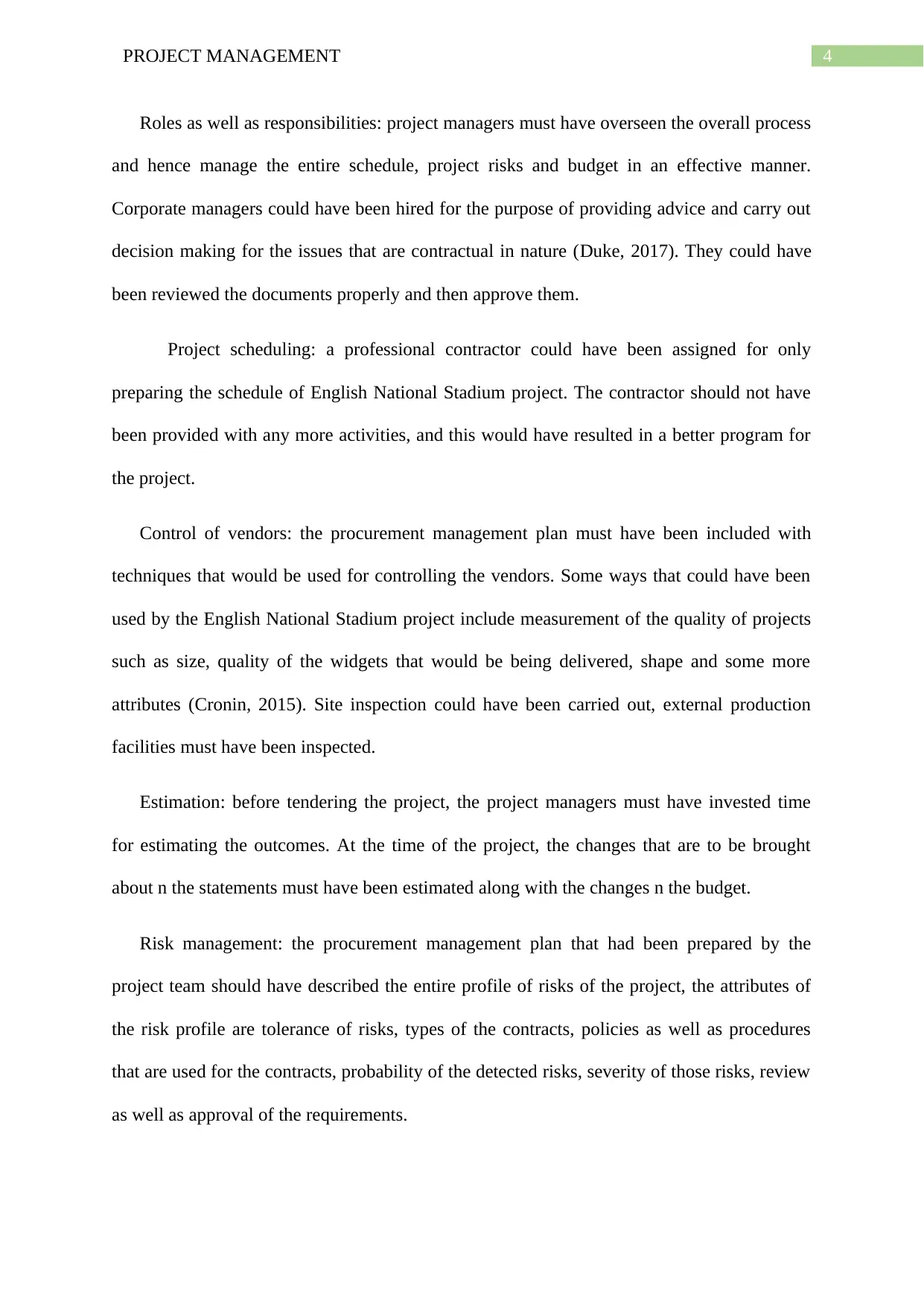
4PROJECT MANAGEMENT
Roles as well as responsibilities: project managers must have overseen the overall process
and hence manage the entire schedule, project risks and budget in an effective manner.
Corporate managers could have been hired for the purpose of providing advice and carry out
decision making for the issues that are contractual in nature (Duke, 2017). They could have
been reviewed the documents properly and then approve them.
Project scheduling: a professional contractor could have been assigned for only
preparing the schedule of English National Stadium project. The contractor should not have
been provided with any more activities, and this would have resulted in a better program for
the project.
Control of vendors: the procurement management plan must have been included with
techniques that would be used for controlling the vendors. Some ways that could have been
used by the English National Stadium project include measurement of the quality of projects
such as size, quality of the widgets that would be being delivered, shape and some more
attributes (Cronin, 2015). Site inspection could have been carried out, external production
facilities must have been inspected.
Estimation: before tendering the project, the project managers must have invested time
for estimating the outcomes. At the time of the project, the changes that are to be brought
about n the statements must have been estimated along with the changes n the budget.
Risk management: the procurement management plan that had been prepared by the
project team should have described the entire profile of risks of the project, the attributes of
the risk profile are tolerance of risks, types of the contracts, policies as well as procedures
that are used for the contracts, probability of the detected risks, severity of those risks, review
as well as approval of the requirements.
Roles as well as responsibilities: project managers must have overseen the overall process
and hence manage the entire schedule, project risks and budget in an effective manner.
Corporate managers could have been hired for the purpose of providing advice and carry out
decision making for the issues that are contractual in nature (Duke, 2017). They could have
been reviewed the documents properly and then approve them.
Project scheduling: a professional contractor could have been assigned for only
preparing the schedule of English National Stadium project. The contractor should not have
been provided with any more activities, and this would have resulted in a better program for
the project.
Control of vendors: the procurement management plan must have been included with
techniques that would be used for controlling the vendors. Some ways that could have been
used by the English National Stadium project include measurement of the quality of projects
such as size, quality of the widgets that would be being delivered, shape and some more
attributes (Cronin, 2015). Site inspection could have been carried out, external production
facilities must have been inspected.
Estimation: before tendering the project, the project managers must have invested time
for estimating the outcomes. At the time of the project, the changes that are to be brought
about n the statements must have been estimated along with the changes n the budget.
Risk management: the procurement management plan that had been prepared by the
project team should have described the entire profile of risks of the project, the attributes of
the risk profile are tolerance of risks, types of the contracts, policies as well as procedures
that are used for the contracts, probability of the detected risks, severity of those risks, review
as well as approval of the requirements.

5PROJECT MANAGEMENT
Figure 1: The English National Stadium
(Source: Andrews-Speed & Tromans, 2018)
Tender evaluation
The purpose of the tender evaluation is the identification of the bid offers that are best for
the project and would tend to provide the most money value to the entire project, which
means the one that would be economically advantageous for the project. The steps that could
have been undertaken by the English National Stadium project for tender evaluation are as
follows
Preparing before tender is issued: the criteria of tender evaluation must be defined before
sending the bid document and the request for proposal (Jelodar, Yiu & Wilkinson, 2016). The
thought process must have been carried out effectively because the criteria that have to be
Figure 1: The English National Stadium
(Source: Andrews-Speed & Tromans, 2018)
Tender evaluation
The purpose of the tender evaluation is the identification of the bid offers that are best for
the project and would tend to provide the most money value to the entire project, which
means the one that would be economically advantageous for the project. The steps that could
have been undertaken by the English National Stadium project for tender evaluation are as
follows
Preparing before tender is issued: the criteria of tender evaluation must be defined before
sending the bid document and the request for proposal (Jelodar, Yiu & Wilkinson, 2016). The
thought process must have been carried out effectively because the criteria that have to be
⊘ This is a preview!⊘
Do you want full access?
Subscribe today to unlock all pages.

Trusted by 1+ million students worldwide

6PROJECT MANAGEMENT
used for the purpose of assessing the necessities of the tender should have been
communicated to all the bidders.
Cost vs. price: the English National Stadium project must have asked regarding any
operational cost, maintenance cost, warehousing cost, consumables, spares, license and many
more charges that are ongoing and might be incurred within the project (Agyekum-Mensah &
Knight, 2017). The costing template that is present in the tender must have allowed for as
well as encourage the bidders for including the costs that have been associated with the
commodity throughout its life cycle.
Quality requirements: the criteria that are not relevant to the cost must have been defined
in the document of bidding. The criteria that could have been used in the evaluation of tender
process might have varied depending on numerous commodities or services that are sourced.
The main criteria's include countless technical issues as well as functional abilities for the
purpose of fulfilling the requirements, technical support along with safe services relevant to
sales, ability of delivering within time and hence complete within the needed timeline,
compliance with the statutory as well as legal requirements, training as well as on-site
installation and the completion of tender and it is signed by authorized personnel.
Assessing the responses received from tender: a vital and initial step that could have been
undertaken by English National Stadium project in the overall process of tender evaluation
include ensuring the fact that various bidders meet the necessities along with the bidders
completely understanding numerous implications as well as the risks that could be imposed
by the implementation of service and delivering the services.
used for the purpose of assessing the necessities of the tender should have been
communicated to all the bidders.
Cost vs. price: the English National Stadium project must have asked regarding any
operational cost, maintenance cost, warehousing cost, consumables, spares, license and many
more charges that are ongoing and might be incurred within the project (Agyekum-Mensah &
Knight, 2017). The costing template that is present in the tender must have allowed for as
well as encourage the bidders for including the costs that have been associated with the
commodity throughout its life cycle.
Quality requirements: the criteria that are not relevant to the cost must have been defined
in the document of bidding. The criteria that could have been used in the evaluation of tender
process might have varied depending on numerous commodities or services that are sourced.
The main criteria's include countless technical issues as well as functional abilities for the
purpose of fulfilling the requirements, technical support along with safe services relevant to
sales, ability of delivering within time and hence complete within the needed timeline,
compliance with the statutory as well as legal requirements, training as well as on-site
installation and the completion of tender and it is signed by authorized personnel.
Assessing the responses received from tender: a vital and initial step that could have been
undertaken by English National Stadium project in the overall process of tender evaluation
include ensuring the fact that various bidders meet the necessities along with the bidders
completely understanding numerous implications as well as the risks that could be imposed
by the implementation of service and delivering the services.
Paraphrase This Document
Need a fresh take? Get an instant paraphrase of this document with our AI Paraphraser
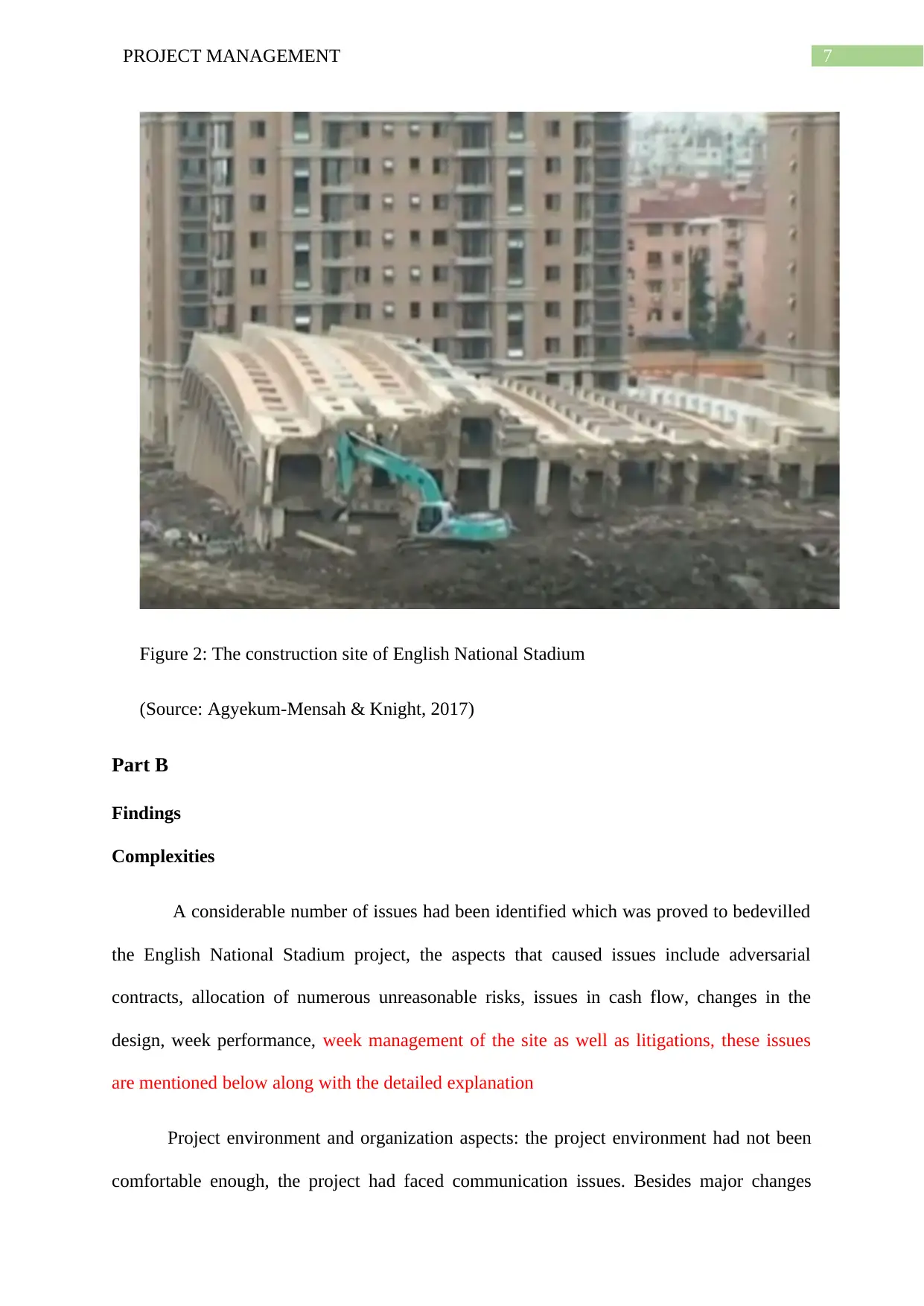
7PROJECT MANAGEMENT
Figure 2: The construction site of English National Stadium
(Source: Agyekum-Mensah & Knight, 2017)
Part B
Findings
Complexities
A considerable number of issues had been identified which was proved to bedevilled
the English National Stadium project, the aspects that caused issues include adversarial
contracts, allocation of numerous unreasonable risks, issues in cash flow, changes in the
design, week performance, week management of the site as well as litigations, these issues
are mentioned below along with the detailed explanation
Project environment and organization aspects: the project environment had not been
comfortable enough, the project had faced communication issues. Besides major changes
Figure 2: The construction site of English National Stadium
(Source: Agyekum-Mensah & Knight, 2017)
Part B
Findings
Complexities
A considerable number of issues had been identified which was proved to bedevilled
the English National Stadium project, the aspects that caused issues include adversarial
contracts, allocation of numerous unreasonable risks, issues in cash flow, changes in the
design, week performance, week management of the site as well as litigations, these issues
are mentioned below along with the detailed explanation
Project environment and organization aspects: the project environment had not been
comfortable enough, the project had faced communication issues. Besides major changes
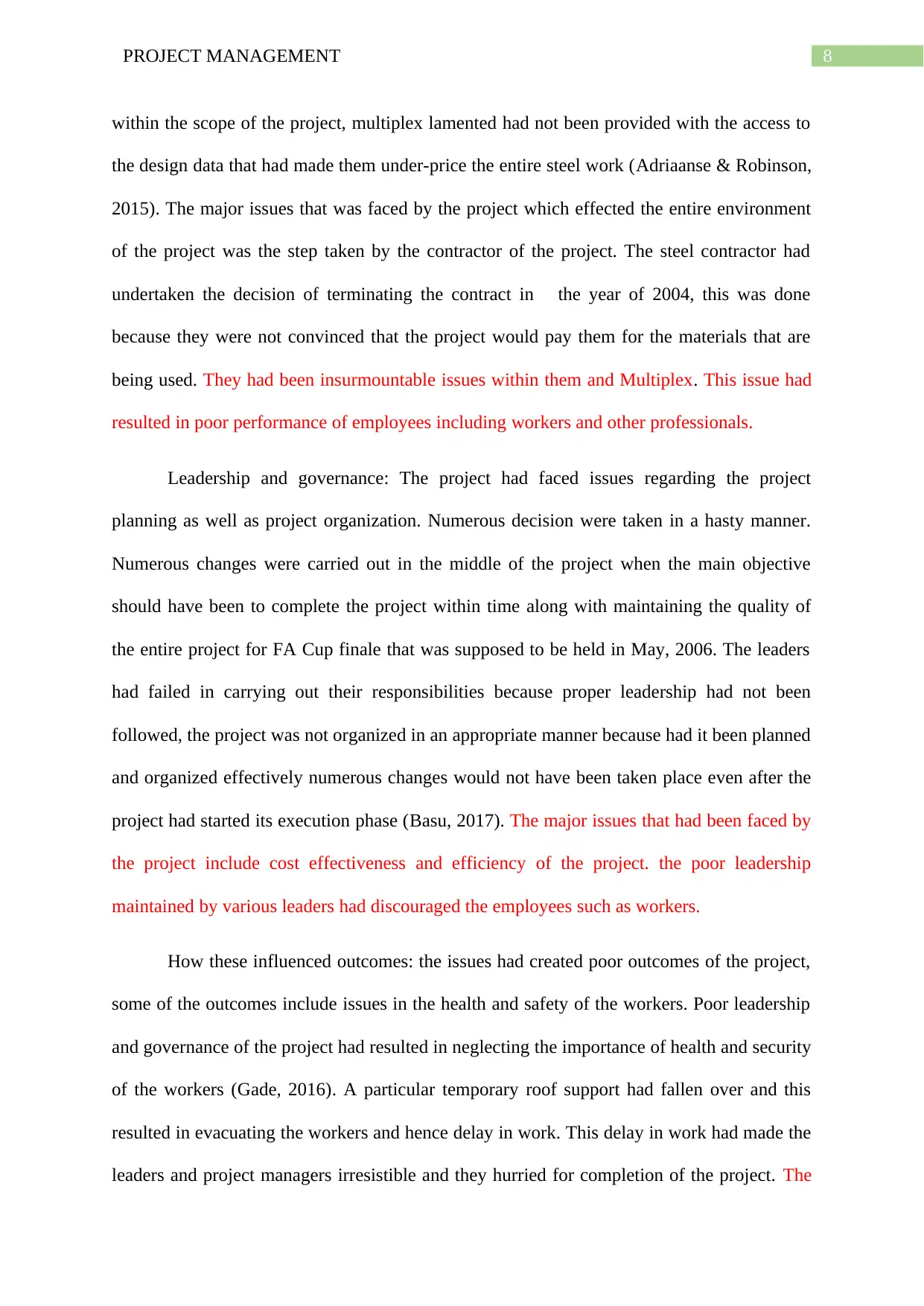
8PROJECT MANAGEMENT
within the scope of the project, multiplex lamented had not been provided with the access to
the design data that had made them under-price the entire steel work (Adriaanse & Robinson,
2015). The major issues that was faced by the project which effected the entire environment
of the project was the step taken by the contractor of the project. The steel contractor had
undertaken the decision of terminating the contract in the year of 2004, this was done
because they were not convinced that the project would pay them for the materials that are
being used. They had been insurmountable issues within them and Multiplex. This issue had
resulted in poor performance of employees including workers and other professionals.
Leadership and governance: The project had faced issues regarding the project
planning as well as project organization. Numerous decision were taken in a hasty manner.
Numerous changes were carried out in the middle of the project when the main objective
should have been to complete the project within time along with maintaining the quality of
the entire project for FA Cup finale that was supposed to be held in May, 2006. The leaders
had failed in carrying out their responsibilities because proper leadership had not been
followed, the project was not organized in an appropriate manner because had it been planned
and organized effectively numerous changes would not have been taken place even after the
project had started its execution phase (Basu, 2017). The major issues that had been faced by
the project include cost effectiveness and efficiency of the project. the poor leadership
maintained by various leaders had discouraged the employees such as workers.
How these influenced outcomes: the issues had created poor outcomes of the project,
some of the outcomes include issues in the health and safety of the workers. Poor leadership
and governance of the project had resulted in neglecting the importance of health and security
of the workers (Gade, 2016). A particular temporary roof support had fallen over and this
resulted in evacuating the workers and hence delay in work. This delay in work had made the
leaders and project managers irresistible and they hurried for completion of the project. The
within the scope of the project, multiplex lamented had not been provided with the access to
the design data that had made them under-price the entire steel work (Adriaanse & Robinson,
2015). The major issues that was faced by the project which effected the entire environment
of the project was the step taken by the contractor of the project. The steel contractor had
undertaken the decision of terminating the contract in the year of 2004, this was done
because they were not convinced that the project would pay them for the materials that are
being used. They had been insurmountable issues within them and Multiplex. This issue had
resulted in poor performance of employees including workers and other professionals.
Leadership and governance: The project had faced issues regarding the project
planning as well as project organization. Numerous decision were taken in a hasty manner.
Numerous changes were carried out in the middle of the project when the main objective
should have been to complete the project within time along with maintaining the quality of
the entire project for FA Cup finale that was supposed to be held in May, 2006. The leaders
had failed in carrying out their responsibilities because proper leadership had not been
followed, the project was not organized in an appropriate manner because had it been planned
and organized effectively numerous changes would not have been taken place even after the
project had started its execution phase (Basu, 2017). The major issues that had been faced by
the project include cost effectiveness and efficiency of the project. the poor leadership
maintained by various leaders had discouraged the employees such as workers.
How these influenced outcomes: the issues had created poor outcomes of the project,
some of the outcomes include issues in the health and safety of the workers. Poor leadership
and governance of the project had resulted in neglecting the importance of health and security
of the workers (Gade, 2016). A particular temporary roof support had fallen over and this
resulted in evacuating the workers and hence delay in work. This delay in work had made the
leaders and project managers irresistible and they hurried for completion of the project. The
⊘ This is a preview!⊘
Do you want full access?
Subscribe today to unlock all pages.

Trusted by 1+ million students worldwide
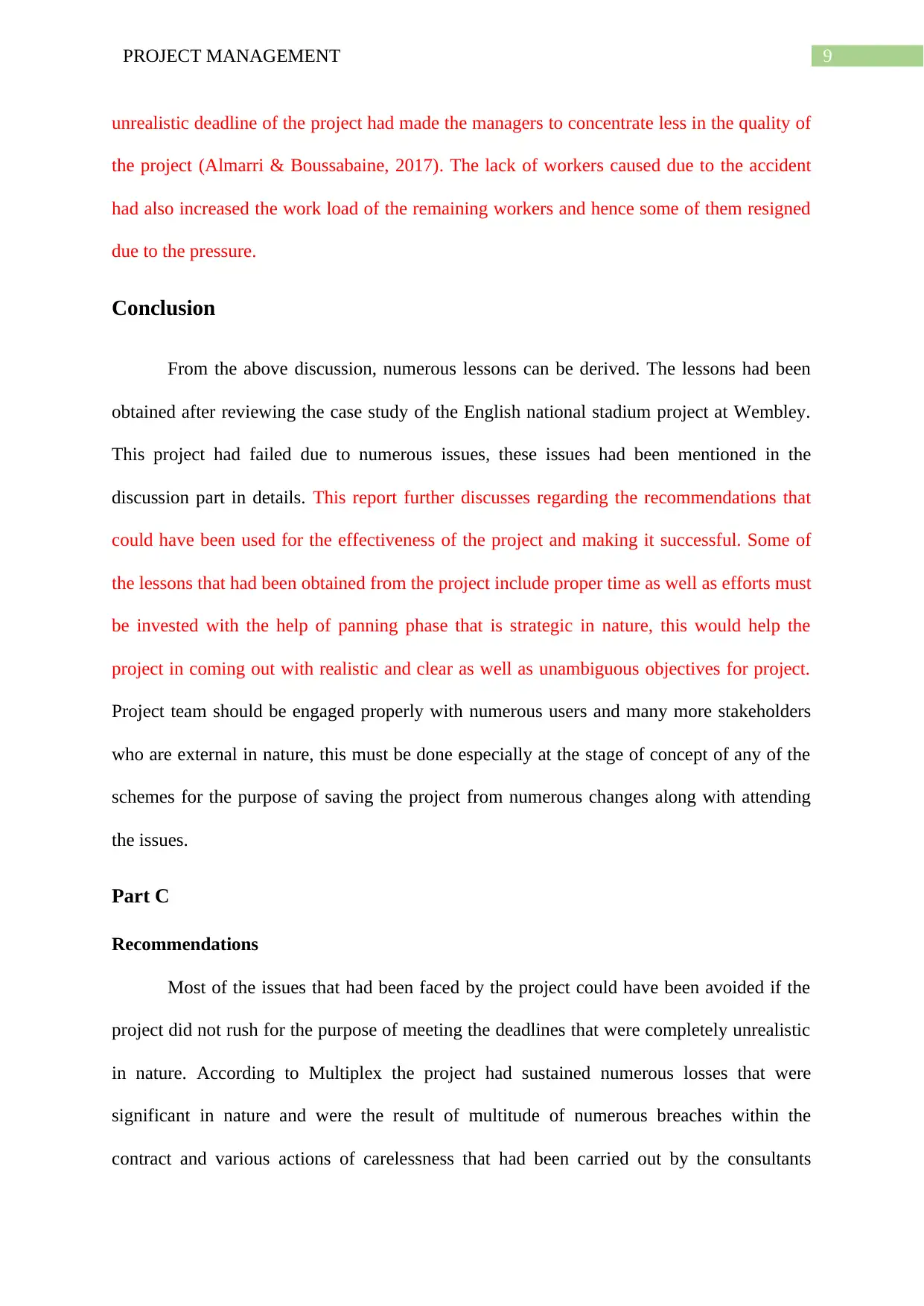
9PROJECT MANAGEMENT
unrealistic deadline of the project had made the managers to concentrate less in the quality of
the project (Almarri & Boussabaine, 2017). The lack of workers caused due to the accident
had also increased the work load of the remaining workers and hence some of them resigned
due to the pressure.
Conclusion
From the above discussion, numerous lessons can be derived. The lessons had been
obtained after reviewing the case study of the English national stadium project at Wembley.
This project had failed due to numerous issues, these issues had been mentioned in the
discussion part in details. This report further discusses regarding the recommendations that
could have been used for the effectiveness of the project and making it successful. Some of
the lessons that had been obtained from the project include proper time as well as efforts must
be invested with the help of panning phase that is strategic in nature, this would help the
project in coming out with realistic and clear as well as unambiguous objectives for project.
Project team should be engaged properly with numerous users and many more stakeholders
who are external in nature, this must be done especially at the stage of concept of any of the
schemes for the purpose of saving the project from numerous changes along with attending
the issues.
Part C
Recommendations
Most of the issues that had been faced by the project could have been avoided if the
project did not rush for the purpose of meeting the deadlines that were completely unrealistic
in nature. According to Multiplex the project had sustained numerous losses that were
significant in nature and were the result of multitude of numerous breaches within the
contract and various actions of carelessness that had been carried out by the consultants
unrealistic deadline of the project had made the managers to concentrate less in the quality of
the project (Almarri & Boussabaine, 2017). The lack of workers caused due to the accident
had also increased the work load of the remaining workers and hence some of them resigned
due to the pressure.
Conclusion
From the above discussion, numerous lessons can be derived. The lessons had been
obtained after reviewing the case study of the English national stadium project at Wembley.
This project had failed due to numerous issues, these issues had been mentioned in the
discussion part in details. This report further discusses regarding the recommendations that
could have been used for the effectiveness of the project and making it successful. Some of
the lessons that had been obtained from the project include proper time as well as efforts must
be invested with the help of panning phase that is strategic in nature, this would help the
project in coming out with realistic and clear as well as unambiguous objectives for project.
Project team should be engaged properly with numerous users and many more stakeholders
who are external in nature, this must be done especially at the stage of concept of any of the
schemes for the purpose of saving the project from numerous changes along with attending
the issues.
Part C
Recommendations
Most of the issues that had been faced by the project could have been avoided if the
project did not rush for the purpose of meeting the deadlines that were completely unrealistic
in nature. According to Multiplex the project had sustained numerous losses that were
significant in nature and were the result of multitude of numerous breaches within the
contract and various actions of carelessness that had been carried out by the consultants
Paraphrase This Document
Need a fresh take? Get an instant paraphrase of this document with our AI Paraphraser
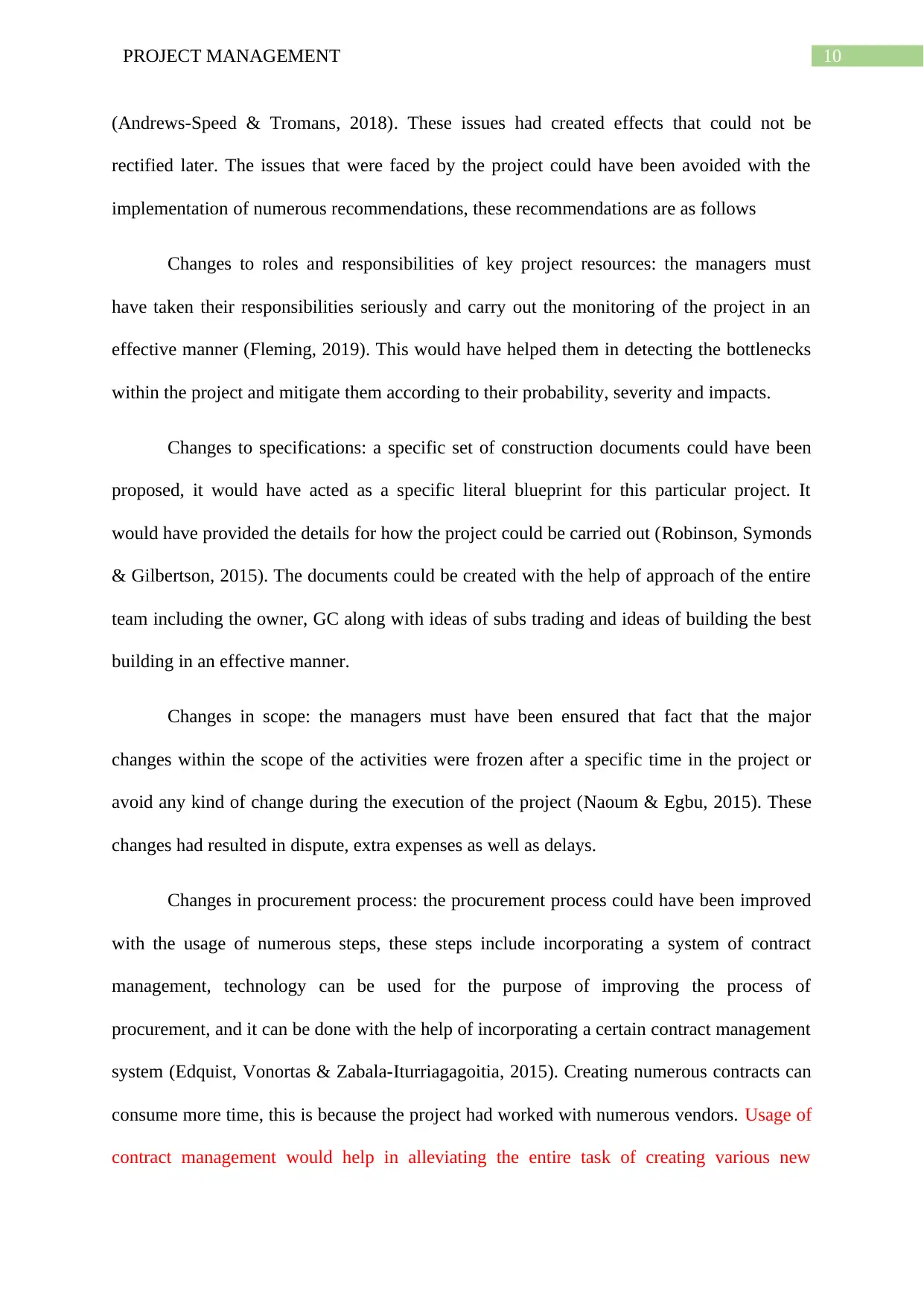
10PROJECT MANAGEMENT
(Andrews-Speed & Tromans, 2018). These issues had created effects that could not be
rectified later. The issues that were faced by the project could have been avoided with the
implementation of numerous recommendations, these recommendations are as follows
Changes to roles and responsibilities of key project resources: the managers must
have taken their responsibilities seriously and carry out the monitoring of the project in an
effective manner (Fleming, 2019). This would have helped them in detecting the bottlenecks
within the project and mitigate them according to their probability, severity and impacts.
Changes to specifications: a specific set of construction documents could have been
proposed, it would have acted as a specific literal blueprint for this particular project. It
would have provided the details for how the project could be carried out (Robinson, Symonds
& Gilbertson, 2015). The documents could be created with the help of approach of the entire
team including the owner, GC along with ideas of subs trading and ideas of building the best
building in an effective manner.
Changes in scope: the managers must have been ensured that fact that the major
changes within the scope of the activities were frozen after a specific time in the project or
avoid any kind of change during the execution of the project (Naoum & Egbu, 2015). These
changes had resulted in dispute, extra expenses as well as delays.
Changes in procurement process: the procurement process could have been improved
with the usage of numerous steps, these steps include incorporating a system of contract
management, technology can be used for the purpose of improving the process of
procurement, and it can be done with the help of incorporating a certain contract management
system (Edquist, Vonortas & Zabala-Iturriagagoitia, 2015). Creating numerous contracts can
consume more time, this is because the project had worked with numerous vendors. Usage of
contract management would help in alleviating the entire task of creating various new
(Andrews-Speed & Tromans, 2018). These issues had created effects that could not be
rectified later. The issues that were faced by the project could have been avoided with the
implementation of numerous recommendations, these recommendations are as follows
Changes to roles and responsibilities of key project resources: the managers must
have taken their responsibilities seriously and carry out the monitoring of the project in an
effective manner (Fleming, 2019). This would have helped them in detecting the bottlenecks
within the project and mitigate them according to their probability, severity and impacts.
Changes to specifications: a specific set of construction documents could have been
proposed, it would have acted as a specific literal blueprint for this particular project. It
would have provided the details for how the project could be carried out (Robinson, Symonds
& Gilbertson, 2015). The documents could be created with the help of approach of the entire
team including the owner, GC along with ideas of subs trading and ideas of building the best
building in an effective manner.
Changes in scope: the managers must have been ensured that fact that the major
changes within the scope of the activities were frozen after a specific time in the project or
avoid any kind of change during the execution of the project (Naoum & Egbu, 2015). These
changes had resulted in dispute, extra expenses as well as delays.
Changes in procurement process: the procurement process could have been improved
with the usage of numerous steps, these steps include incorporating a system of contract
management, technology can be used for the purpose of improving the process of
procurement, and it can be done with the help of incorporating a certain contract management
system (Edquist, Vonortas & Zabala-Iturriagagoitia, 2015). Creating numerous contracts can
consume more time, this is because the project had worked with numerous vendors. Usage of
contract management would help in alleviating the entire task of creating various new

11PROJECT MANAGEMENT
contracts every time the project teds to on board a specific supplied that had not been a part
previously. Changes within the procurement process had resulted in making employees loose
hope from the entire project and hence they did not concentrate on their performances.
contracts every time the project teds to on board a specific supplied that had not been a part
previously. Changes within the procurement process had resulted in making employees loose
hope from the entire project and hence they did not concentrate on their performances.
⊘ This is a preview!⊘
Do you want full access?
Subscribe today to unlock all pages.

Trusted by 1+ million students worldwide
1 out of 14
Related Documents
Your All-in-One AI-Powered Toolkit for Academic Success.
+13062052269
info@desklib.com
Available 24*7 on WhatsApp / Email
![[object Object]](/_next/static/media/star-bottom.7253800d.svg)
Unlock your academic potential
Copyright © 2020–2025 A2Z Services. All Rights Reserved. Developed and managed by ZUCOL.




